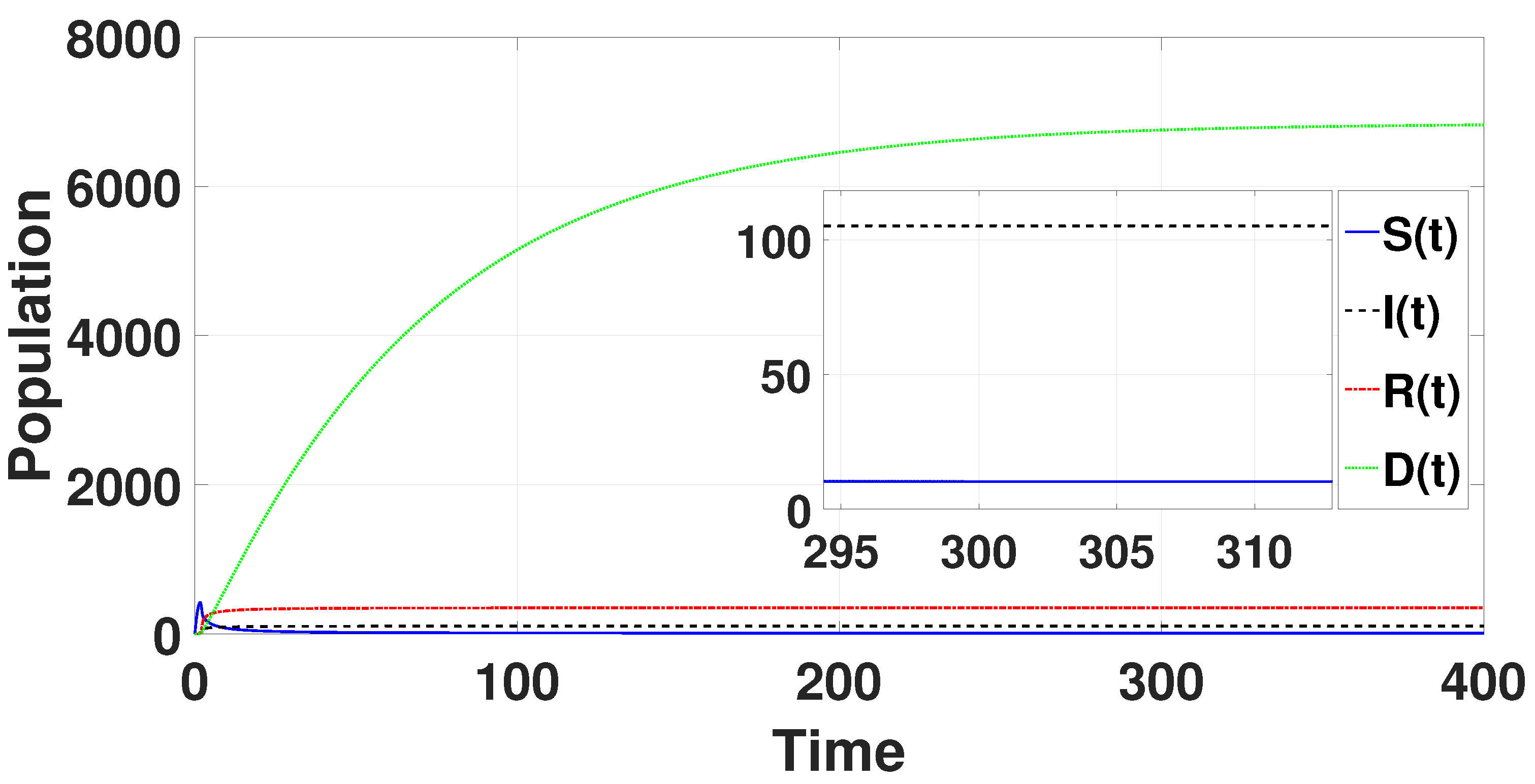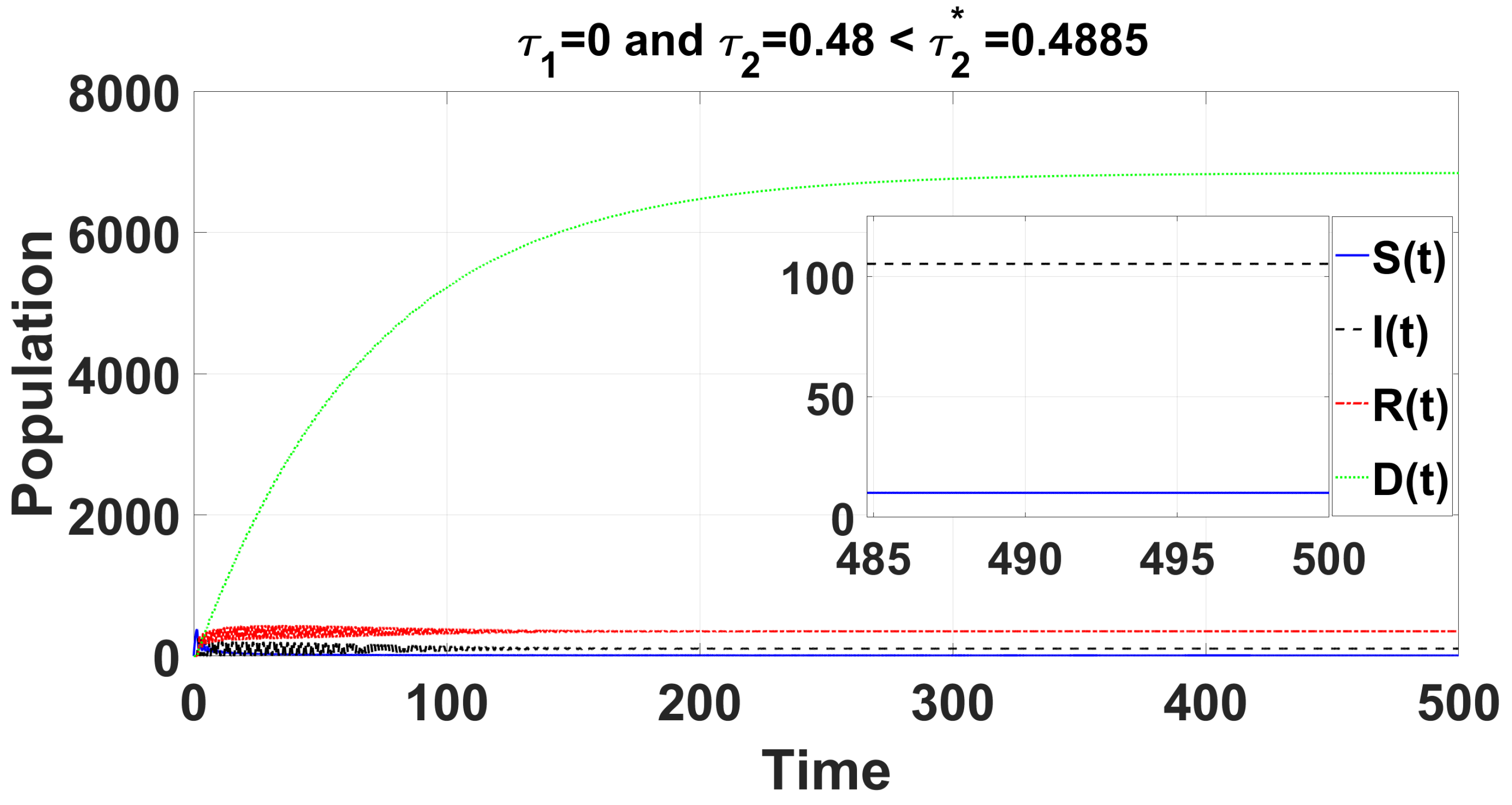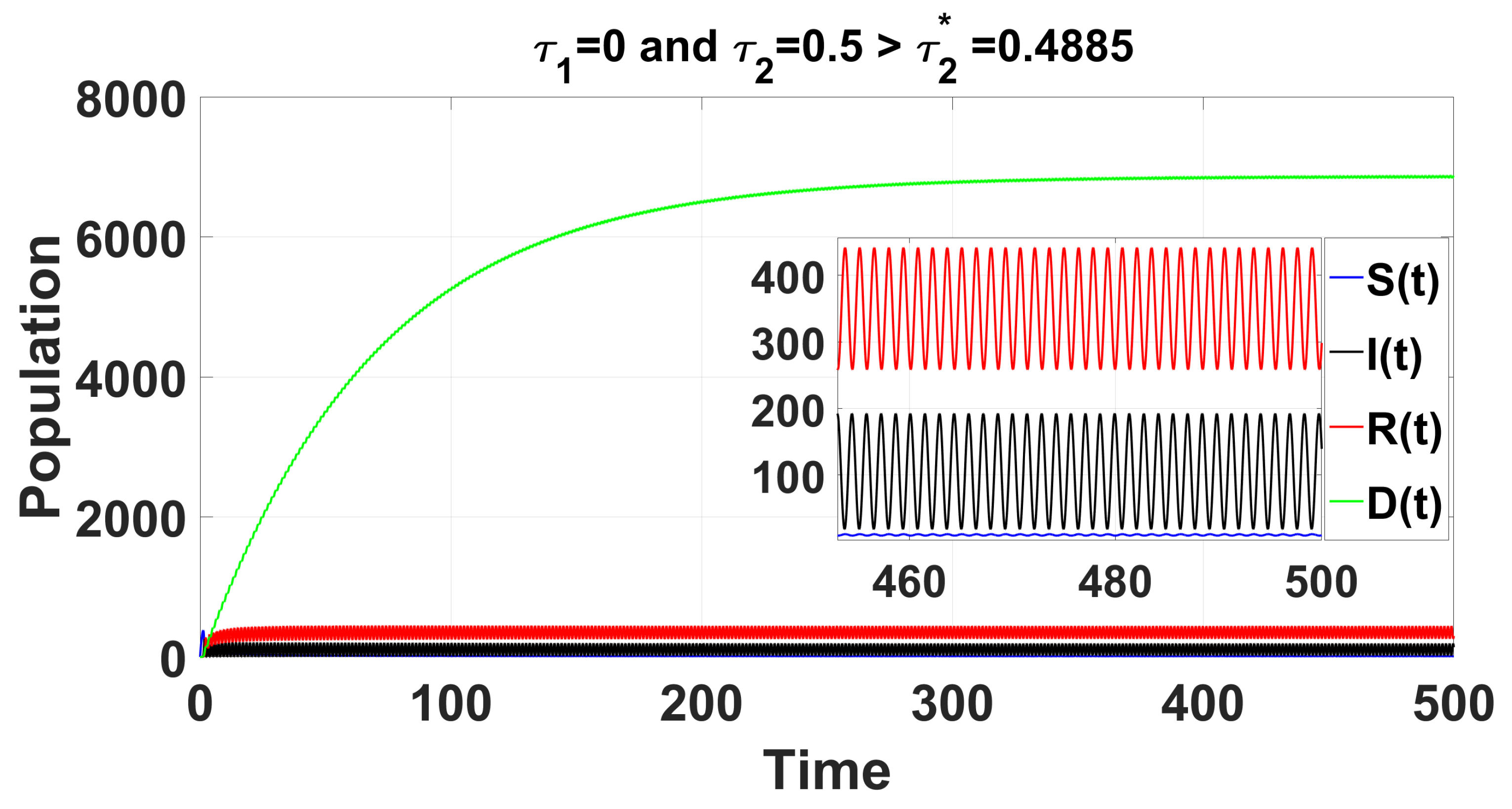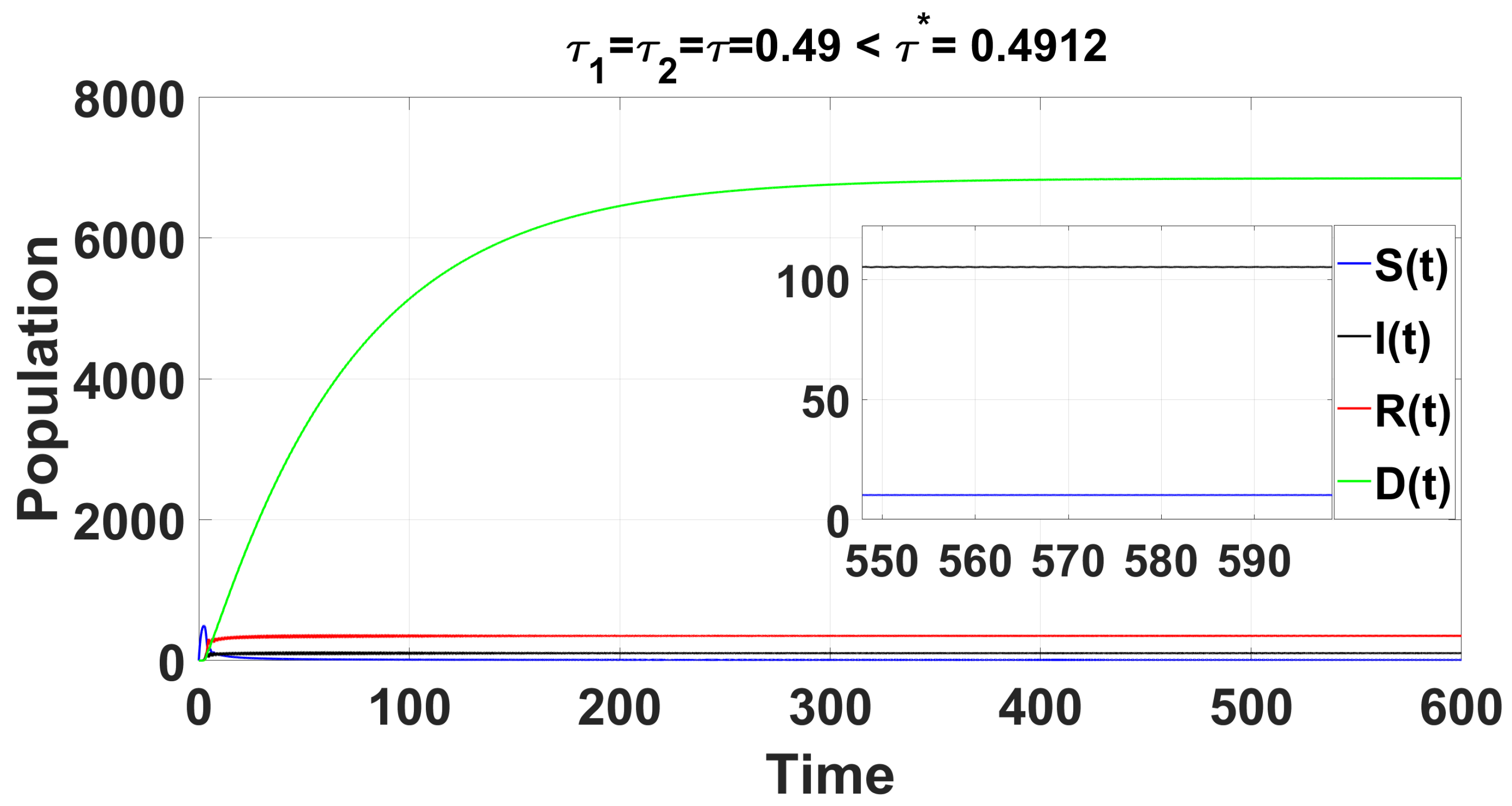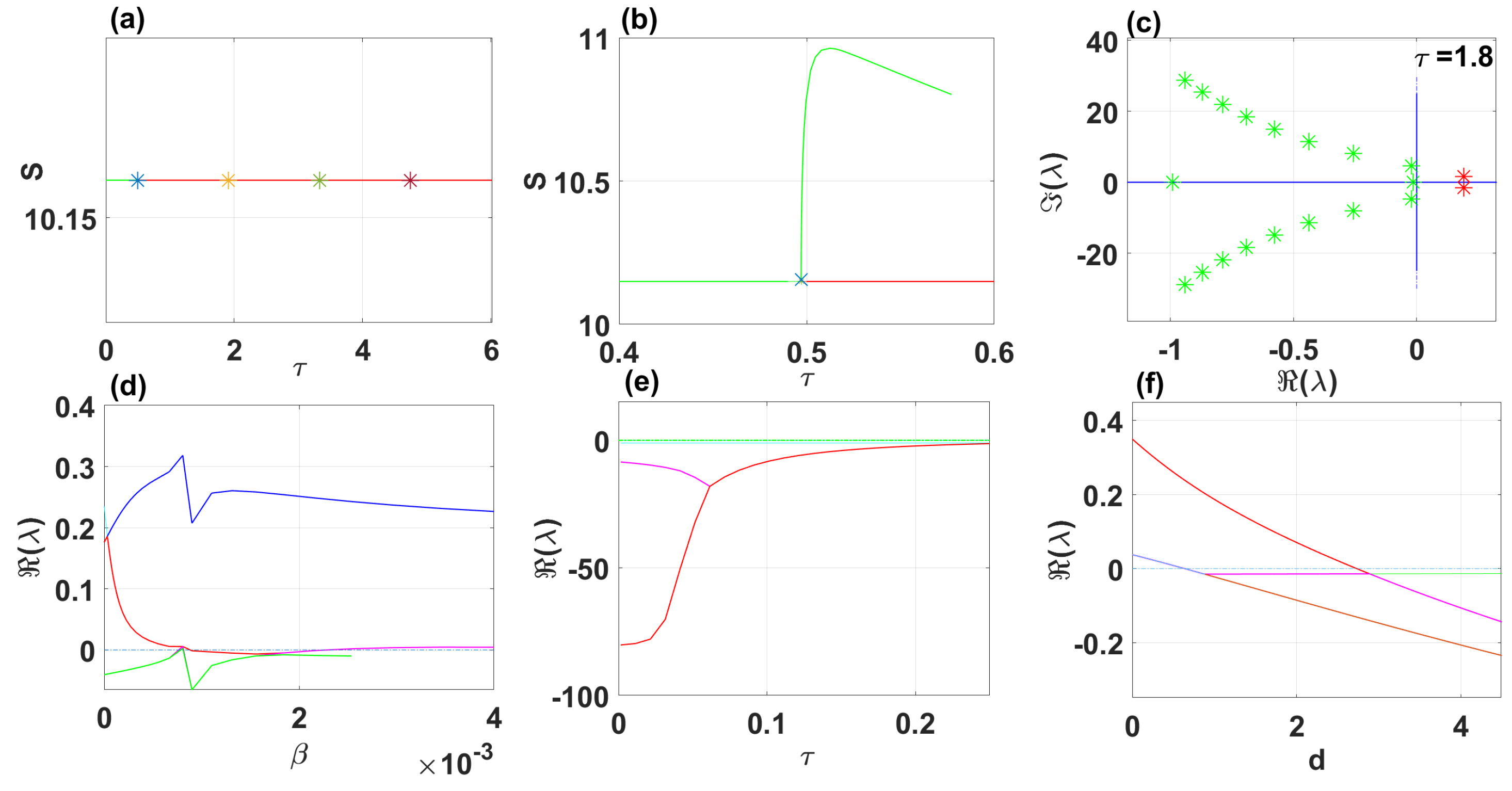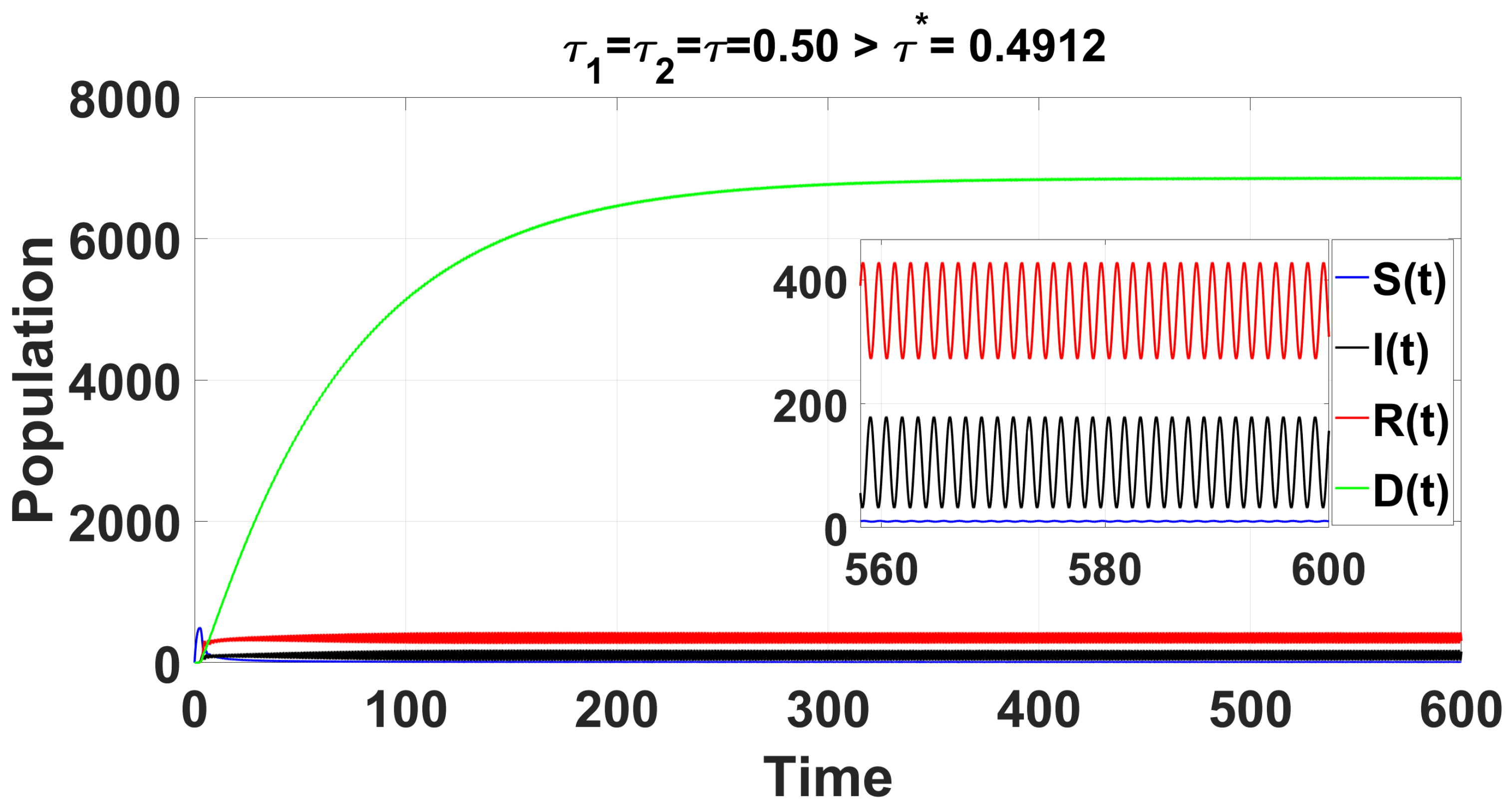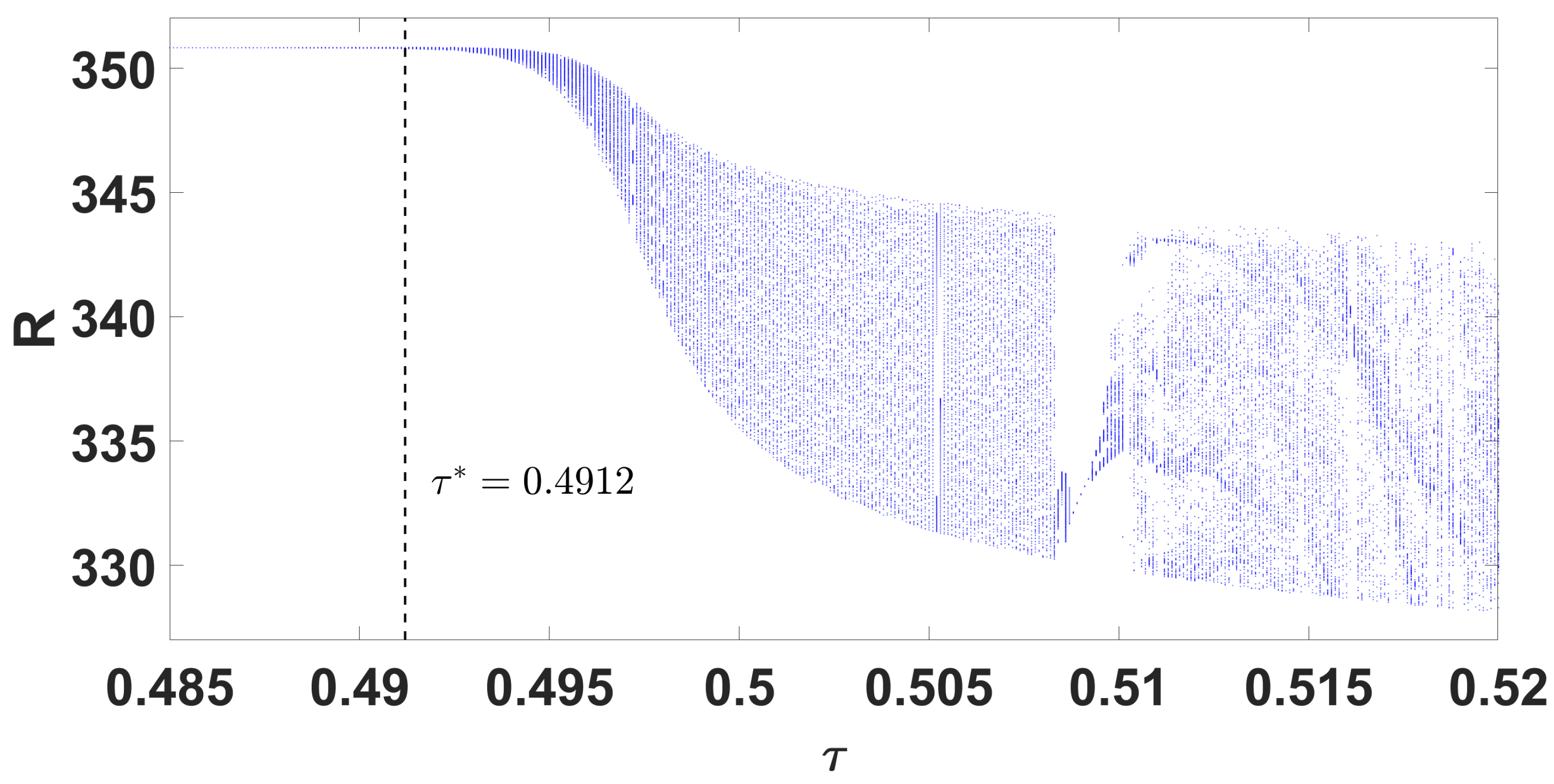1. Introduction
Ebola virus disease was first discovered in 1976, and among infectious diseases, it is one of the most perilous known to humanity. The death rates for people infected with this disease are very high and may reach 90 percent in some cases [
1]. The Ebola virus spreads widely among humans in several ways, and infection occurs during the processes of consumption, cooking, or preparation. Individuals may encounter infected animals and come into contact with clothing or items that contain the bodily fluids of an infected person; contact with their urine, feces, semen, or saliva can cause transmission to occur. Ebola enters the body through the liver or when the nose, mouth, or eyes are bitten. In addition, the Ebola virus is also spread to humans by fruit bats, chimpanzees, and monkeys [
2,
3]. From 2 to 21 days is the range for Ebola’s incubation period, with symptoms such as skin rash, vomiting, diarrhea, and tremors, and severe cases can lead to internal and external bleeding [
1,
4]. The epidemic had a severe impact on many countries. To curb the rapid spread of the disease, quarantining—a time-tested method—is implemented to isolate those suspected of being infected. Even though it has proved effective in controlling the disease, it also poses significant challenges for public health. Furthermore, direct contact with the deceased during burial ceremonies can facilitate the transmission of the disease [
5,
6].
The dynamics of Ebola transmission have been extensively studied, revealing insights into the disease’s spread and control. Zoonotic transmission between dogs and humans [
7], the progression of the disease through different stages [
8], and the impact of density-dependent treatment approaches on Ebola transmission [
9] have been explored. A modified mathematical model incorporating quarantining as a control strategy has also been developed [
10]. In addition, research has focused on direct and indirect transmission routes; as stated in [
11], the models incorporated a composite nonlinear incidence function along with density-independent treatment. The significance of vaccination in reducing mortality among confirmed Ebola patients is highlighted in an observational study [
12]. A comprehensive eight-dimensional nonlinear differential equations model is presented to better understand Ebola transmission dynamics [
13]. The role of optimal control strategies in human–bat transmission dynamics is also investigated [
14]. This study aims to model the dynamics of Ebola by incorporating time delay, immunity, quarantining, and nonlinear perturbations as control mechanisms. The influence of quarantine, medical resource availability, the latent period, and treatment delays were key factors in this study, especially during the early phases of model development. As the research progressed, additional characteristics of Ebola were integrated to enhance the model. The critical roles of quarantine and medical resources, along with the latent period’s significance in Ebola dynamics, are central to this research. This study, inspired by previous research [
15], aims to develop computational models focusing on time delays and quarantine for effective Ebola control, particularly in outbreaks like those in Western Guinea. The research also draws inspiration from studies that used modeling methods to understand and mitigate Ebola [
16,
17].
Delay differential equations (DDEs) offer a more complex dynamic than ordinary differential equations, as the introduction of time delays can destabilize previously stable equilibria, leading to population fluctuations [
18,
19,
20]. This makes the study of delays essential for understanding population dynamics, especially in the context of epidemics, where various infectious diseases exhibit different types of delays during their spread. A comprehensive overview of the relevance of DDEs in population dynamics and epidemics is given in [
21]. Various scenarios with the inclusion of delays have been analyzed by researchers, including vaccination periods [
22], asymptomatic carriage and infection periods [
23], immunity periods, and incubation or latent periods [
23,
24,
25,
26]. In [
27], the research focuses on an SEIRS model, specifically examining the impact of constant delays on both immune periods and the latent period, and [
23] analyzes a model with delays in both asymptomatic carriage period and incubation. In addition, the authors of [
28] examined the stability of periodic solutions within a delayed feedback control system and the existence of bifurcation.
Hopf bifurcation in virus infection models with three delays and CTL responses is the focus of study in [
29]. A delayed SIQR epidemic model is explored, and different pairs of delays are used as bifurcation parameters in [
30]. A delayed SEIS epidemic model, including an analysis of Hopf bifurcation, is explored in [
31].
In a more detailed study, the authors of [
32] developed a model of the Ebola epidemic that takes into account the loss of immunity, limited medical resources, and the identification and isolation of susceptible individuals. However, their analysis was limited to the disease-free equilibrium, and they did not include time delays or control measures. Our study extends this work by introducing two critical time delays: the incubation period delay and the treatment initiation delay. These delays provide a more realistic representation of disease progression and medical response. In addition, we present two optimal control strategies—quarantine and immune enhancement—allowing us to study their impact on disease control. Furthermore, unlike the original study, we analyze the stability of the endemic equilibrium and explore the conditions under which Hopf bifurcation occurs, leading to periodic outbreaks. This expanded analysis provides deeper insights into disease dynamics and the effectiveness of public health measures.
The inclusion of two time delays, (incubation period delay) and (treatment delay), is of biological and mathematical importance. The incubation delay captures the period between infection and contagion, which affects the early dynamics of the outbreak. The treatment delay represents the delay in medical intervention, which affects recovery rates and disease persistence. Mathematically, these delays act as bifurcation parameters, meaning that if they exceed certain critical thresholds, the system undergoes Hopf bifurcation, leading to persistent oscillations in the spread of the disease. This suggests that reducing treatment delays could be an effective strategy to prevent periodic outbreaks and control an epidemic more efficiently.
The rest of this article is organized as follows: In
Section 2, we develop a mathematical model that incorporates multiple time delays, and for the solution, we establish boundedness and positivity.
Section 3 presents an analysis of the disease-free equilibrium local stability and derives the conditions necessary for the local stability of the interior equilibrium point.
Section 4 provides a comprehensive analysis of Hopf bifurcation, focusing on both the stability characteristics of the resulting periodic solutions and the direction in which the bifurcation occurs. Further, in
Section 5, the associated optimal control system’s formulation and solution are detailed. Numerical simulations confirm the theoretical results in
Section 6.
2. Formulation of the Model and Analysis of Solution Positivity
Our study is built upon the epidemiological model proposed in [
32], which considers the dynamics of infection, recovery, and deceased individuals who are not yet buried. We extend this model by incorporating time delays and control strategies to analyze disease dynamics more comprehensively.
This model employs a framework to classify the population into four categories: susceptible (S), infectious (I), recovered (R), and deceased individuals awaiting burial (D). It also explores the latent period for those exposed to the infection, specifically measuring the time from the initial Ebola virus infection to the appearance of symptoms. This period can be affected by the overall viral transmission rate within the community and the individual’s immune response. It is understood that recovered individuals, labeled as R, gradually lose their immunity over time and reintegrate into the susceptible population. Moreover, in light of the widespread nature of the virus, effective tracing and quarantining of susceptible individuals can play a critical role in controlling the outbreak. This is mainly demonstrated through a decrease in the transmission probability, denoted as u.
In our study, we define (for susceptible individuals) the latent period
; these parameters represent the time intervals that elapse from the moment an individual is infected until they become capable of transmitting the infection, and for the delay in treatment, we denote this as
; this represents when infected individuals do not recover immediately after infection but only after a period of delay due to treatment such as diagnosis and medical intervention.
with the initial conditions
Here,
,
, with
and
Further,
is described in detail in [
33]. In the model equations, the deceased compartment
D only accumulates individuals who die due to infection at a rate of
. Naturally deceased individuals with a rate of
d from the compartments
, and
R do not enter into
D and are directly removed from the system. Furthermore, our model includes time delays, with a particular focus on the disease latent period represented by the parameter
and the delay in treatment denoted by
, where
. The model parameters are defined in
Table 1.
To model the interactions between the four compartments, we propose the following assumptions:
The variable u ranges from 0 to 1; when , the quarantine measures are ineffective, while indicates that the quarantine is fully enforced;
Delayed effects: Individuals infected at time become infectious later at time t, so we express their contribution to infectivity as . Likewise, captures the treatment delay from to recovery at time t for infectious individuals.
The disease-free equilibrium (DFE) point of the model (
1) is given by
, where
. A critical parameter, the basic reproduction number (BRN), represented as
, often influences the stability of the equilibrium points within the system. This important factor shows how many new infections one sick person can cause while they are contagious in a population where everyone else is at risk of becoming infected.
We determine the basic reproduction number of model (
1)
for the system using the next-generation matrix [
37,
38]. It is similar to that used in [
32]. However, for the reader’s interest, we provide a sketch of the idea. The disease-free equilibrium (DFE) of the system (
1) is given by
At the DFE, the matrices
and
, representing the rate of appearance of new infections and the rate of transfer between compartments, respectively, are defined as follows:
The Jacobian matrices of
and
at
are computed as
The next-generation matrix is given by
By computing the spectral radius of
, we obtain
Here, the first term represents the expected number of secondary cases produced by an infected individual in a fully susceptible population, while the second term accounts for the contribution of deceased but not yet buried individuals.
Solution Positivity and Boundedness
We provide the following lemma, which is pertinent to this field, to prove the positivity and eventual boundedness of the solutions
,
,
, and
of model (
1).
Lemma 1. Let with the initial conditions given by (2) be the solution to system (1). Then, Moreover, if holds for , then Proof. From (
2), it is clear that
. Suppose we assume that there exists
such that
for any
. Further, assume that
and
for any
.
From the first equation of (
1), we obtain
This contradicts the fact that
and
for
. Now, from the remaining equations of (
1), we obtain
From the above equations and the fact that
, we have
and
for some
This proves (
3).
Consider the delayed system in (
1) as
By using (
1) and (
2), we have
Based on the discussion above and the use of the comparison principle, as a result, . □
4. Hopf Bifurcation: Direction and Stability
In this section, we investigate the direction of the Hopf bifurcation and the stability of the bifurcating periodic solutions of system (
1) with
We analyze the properties of Hopf bifurcation at the critical value
using the center manifold theorem and the normal form theory [
39]. We show that for any one of the critical values,
by
Suppose
and
The linearization of system (
8) at
is given by
where
Given , with , define and .
Thus,
serves as the Hopf bifurcation parameter. As a result, we work within the fixed phase space
, which does not depend on the delay
. Within space
C, system (
8) is reformulated into a functional differential equation as
where
and
with
and
where
. There is a function
with bounded variation for
, according to the Riesz representation theorem, such that
Actually, we may have
with
being the Dirac delta function. For
, we define
and
Then, model (
9) is equivalent to
where
for
. For
, define
Given that
and
are adjoint operators, the eigenvectors of
A and
corresponding to
and
, respectively, are
and
. In this context,
. In light of the established definitions of the function
and the operator
, it becomes evident that we can express the following relationship in a more generalized form:
For , we obtain
The eigenvector of corresponding to can be similarly obtained, where
By using (
12), we can determine the value of
D needed to ensure that
.
Therefore, we can choose
D as
such that
. Assume
is the solution to (
11) under the specific condition where the parameter
is set to zero. Now, we define
On the center manifold
, we have
, and
We concentrate on the real solution
of (
11), assuming that
M remains real if
is real. The local coordinates for the center manifold
in the directions of
and
are denoted by
z and
. With
, we obtain
We write the equation as
, where
Equations (
14) and (
15) imply that
From Equation (
13), we have
and
,
, and
; then,
Along with (
10), we can have
with
From (
15) and (
16), we obtain
We are also required to determine
and
. By using (
11) and (
13), we obtain
where
Notice that on the center manifold
close to the origin,
From system (
20), for
,
By comparing the coefficient with (
23), we obtain
and
From (
25), (
28), and the def. of
A, we obtain
Noticing
, we have
where a constant vector in
is defined as
. A similar result can be obtained:
In the following, we determine
and
. By using the definition of
A and (
25), we obtain
where
. From (
20) and (
23), we have
The coefficients of
and
in
are given, respectively, as follows, where
and
:
By inserting (
29) and (
33) into (
31) and observing that
and
we finally have
which leads to
, where
where
We can compute
using
and
, which can be calculated from (
29) and (
30); that is,
where
Similarly, substituting (
30) and (
35) into (
32), we obtain
where
Therefore, we obtain
where
The main result is deduced based on the conclusion of Hassard et al. [
39]. The stability of the bifurcating periodic solution is influenced by
: the solution will be stable (unstable) if
(
).
determines the direction of the Hopf bifurcation; if
(
), the Hopf bifurcation is supercritical (subcritical). Finally,
determines the period of the bifurcating periodic solution, which increases (decreases) if
(
).
6. Numerical Simulations
In this section, we employ numerical simulations to illustrate our theoretical findings using the dde23 MATLAB built-in solver and DDE-Biftool [
42], a MATLAB package for numerical continuation and bifurcation analysis of delay differential equations (DDEs). The manual for the latest version of DDE-Biftool is available in [
43].
System (
1) is represented by the following form for the parametric values provided in
Table 1.
System (
49) has a unique endemic equilibrium
as
for the parametric values provided in
Table 1. By using the above-mentioned Matlab tool, the unique endemic equilibrium is determined to be
= (10.1495, 105.157, 350.815, 6845.02), which for
is locally asymptotically stable (refer to
Figure 1).
In
Figure 2, the solution curves are presented. Theorem 6 confirms that no Hopf bifurcation occurs in system (
49). For
, and
; furthermore, according to (
A21), we find
where
; then, point
remains locally asymptotically stable for all
with
Now, for
and
, we find
and
. Additionally, we have
. Thus, we can conclude that the equilibrium point
is locally asymptotically stable when conditions
and
(see
Appendix C) are satisfied for
. However, as
approaches
,
will switch stability, becoming unstable and undergoing a Hopf bifurcation at
. This transition leads to the emergence of a family of periodic solutions bifurcating from
near
.
By using DDE-Biftool, we find that when
, there are four critical delays:
(see
Figure 3). Notice that the stability switches occur at the Hopf bifurcation points, leading to a total of seven stability switches. The stable and unstable regions of the branch are represented in green and red, respectively. The branch of periodic solutions emerges from the first critical delay at the Hopf bifurcation point
(see
Figure 3b). This behavior is further illustrated by the bifurcation diagram in
Figure 4, with additional solution curves shown in
Figure 5 and
Figure 6.
Through theoretical analysis, we have determined
. Meanwhile, when using DDE-Biftool, the first critical delay is
. This indicates that our theoretical result is very close to the outcome obtained from DDE-Biftool. The
Figure 7 illustrates the projection of the solutions in the
phase space influenced by the delay.
Through complex computations, we find that
and
(see
Appendix C) are satisfied when
. This leads to the following results:
,
,
, and
. From Equation (
36) in
Section 4, we determine that
,
,
, and
. As illustrated by the computer simulations (see
Figure 8), the positive equilibrium
is asymptotically stable when
. Once
exceeds the critical value
, a Hopf bifurcation occurs, causing
to lose stability, giving rise to a family of periodic solutions that bifurcate from
.
When using DDE-Biftool with
, four critical delays are identified:
(see
Figure 9). Notably, stability switches occur at the Hopf bifurcation points, resulting in a total of seven stability switches. The stable and unstable portions of the branch are represented in green and red, respectively. The branch of periodic solutions emanates from the first critical time delay at the Hopf bifurcation point
(see
Figure 9). It is important to note that through our theoretical analysis, we find
, whereas when using DDE-Biftool, the first critical delay is
. This indicates that our theoretical result is very close to the outcome from DDE-Biftool.
The conditions
and
indicate a supercritical Hopf bifurcation, with bifurcation occurring for
. The periodic solutions bifurcating from
at
are stable, as depicted in
Figure 10; system (
49) also undergoes a Hopf bifurcation near
, which is demonstrated in the bifurcation diagram (
Figure 9b and
Figure 11). The right side of
Figure 12 denotes the projection of the solutions in
.
Figure 13 shows eigenvalues of the disease-free branch with
(a). (b) and (c) show the real parts of eigenvalues vs.
and
, respectively.
Optimal Control Strategies: Numerical Analysis
This section examines the best control strategy using a numerical example for the
model. We analyzed the results to better understand how different strategies can impact the spread of the disease. The initial population distribution is given by
. From the adjoint and state equations, we first derive the optimality system and, subsequently, solve pandemic model (
1) with time delay, control system (
37), adjoint Equation (
42), the initial conditions (
2), and the transversality conditions (
43); simulations were carried out using a numerical method derived from the standard Runge-Kutta.
The dynamics of an infected human population can be analyzed by comparing scenarios with and without control interventions. In the given analysis, we refer to the specific parameter values outlined in
Table 2, which provide a basis for understanding the effectiveness of these interventions.
As illustrated in
Figure 14,
Figure 15 and
Figure 16, the model depicts two distinct scenarios: the solid lines represent the population without any form of control, and the dashed lines signify the population under implemented control measures. The weights assigned in the objective function are
,
,
,
, and
, and these are essential for determining the priorities of different control strategies, influencing the model’s outcomes.
The numerical simulations of the SIRD model investigated the impact of two control strategies, efficiency of quarantine protocols () and immunity enhancement (), on achieving a (DFE) . Each control strategy was tested individually and in combination, revealing both their strengths and limitations.
Case 1: Quarantine protocols only ()
In this case, the populations of infected individuals (
I), recovered individuals (
R), and deceased individuals (
D) dropped to zero after 160 days, as shown in
Figure 14a. The control
was applied at the maximum level for 15 days. After that, we gradually reduced the control application until it was maintained for 70 days at a decreased level. We continued to apply the control at this consistent level for a total of 280 days, after which we significantly decreased the application by 295 days. This approach was effective in reducing disease transmission, but it required long-term implementation, which may be resource-intensive.
Case 2: Immunity enhancement only ()
In this scenario, the infected (
I) and deceased (
D) populations increase slightly, and the recovered individuals (
R) decrease, as shown in
Figure 15a. The control
is applied at its maximum level for 50 days, and then it drops sharply until day 60, after which it remains stable, as shown in
Figure 15b. This strategy alone is not sufficient to eliminate the disease, so we conclude that applying this control by itself is ineffective.
Case 3: Combined control strategy ()
The combined application of two controls yielded the most efficient results. Populations (
I), (
R), and (
D) dropped to zero after 95 days, as presented in
Figure 16a. The controls were applied for 20 days (
) and 50 days (
), as displayed in
Figure 16b. This integrated approach addressed multiple aspects of disease dynamics simultaneously, achieving faster and more sustainable results than any single intervention.
Each strategy has its advantages and disadvantages. Quarantine protocols () are effective at reducing transmission but require sustained effort, resources, and time. Immunity enhancement () does not prevent new infections and is insufficient to achieve a disease-free state. The combined strategy, while highly effective, may require significant coordination and investment. These findings are crucial for public health planning. They demonstrate that while individual controls can lead to disease-free outcomes, a combined approach is the most robust and efficient. By implementing these strategies, communities can enhance their resilience to outbreaks, save lives, and promote long-term public health stability.
7. Discussion
In this work, we propose a delayed
model system that highlights three key concepts: (i) the inclusion of a separate compartment for dead but not yet buried individuals, (ii) the loss of immunity, and (iii) the introduction of a treatment recovery function,
, which measures the impact of limited medical resources. The influence of hospital beds and vaccines on disease dynamics was recently detailed by Wang et al. [
32], and numerous mathematical models in epidemiology have thoroughly explored the issue of whether recovered individuals have temporary or permanent immunity [
45,
46]. The results obtained in this paper complement the research work in the literature [
32]; our study extends the work of Wang et al. [
32] by examining how delay parameters influence system dynamics. Consequently, our proposed model system (
1) is made more realistic, particularly when considering diseases like Ebola; after a period of immunity, a recovered person can become susceptible again, as their immunity may only be temporary. We incorporated two time delays into the proposed
epidemic model: the latent period for susceptible individuals and treatment delay (due to limited medical resources, also known as the treatment period).
The analysis covers optimal control strategies and explores the model’s solution positivity, boundedness, stability, and Hopf bifurcation to understand better how to manage the system. Additionally, this study investigates the effect of time delay parameters on the dynamics of the model system. The significance of quarantine and boosting immunity in controlling the spread of infection is proven. This paper highlights the importance of quarantine and enhanced immunity in managing an infected population. The primary focus is to examine how the delay parameter influences the system dynamics. Additionally, we explore strategies to enhance quarantine measures, improve disease tracking, and boost immunity levels. Quarantine programs, in particular, are essential for safeguarding individuals and curbing the spread of infectious diseases. This is especially evident in the case of Ebola, where quarantine plays a critical role, underscoring the importance of public awareness regarding seasonal quarantine practices.
Additionally, we found that the combined application of both controls yielded the most efficient results, achieving a disease-free state within 95 days, whereas applying only quarantine protocols took 160 days to reach the same outcome. For various ranges of delay parameters (
and
), the sufficient conditions for local stability of the DFE are explored in Theorems 2–4. The existence of the endemic equilibrium, which is valid when
, is directly derived from [
32]. We have used the comparison theorem to establish solution boundedness and applied the elementary theory of functional differential equations to ensure the existence and uniqueness of solutions for the proposed model system. Moreover, local stability conditions for the endemic equilibrium
are discussed regarding different delay parameter values. In Theorems 7–8, the critical values of both time delays are determined, and the occurrence of Hopf bifurcations is analyzed by treating the delays as bifurcation parameters. Our analysis shows that if the values of time delay
and the
parameters for system (
1) are below their corresponding critical values, the endemic equilibrium remains stable. However, if any delay parameters exceed their critical values, the stability of the endemic equilibrium is lost. One-parameter bifurcation diagrams for different bifurcation parameters are presented in
Figure 4 and
Figure 11, and the threshold values of the delay parameters are calculated. We used DDE-Biftool to analyze the endemic equilibrium branch and plot the branch of periodic solutions originating from the first bifurcation point,
, with
. Additionally, we examined the eigenvalues along the endemic equilibrium branch for
and
, as well as for
. We also plotted the real parts of the eigenvalues with respect to
,
(with
), and
d, respectively. See
Figure 3 and
Figure 9. We used the same tool to plot the eigenvalues along the disease-free equilibrium branch for
. Additionally, we plotted the real parts of the eigenvalues as functions of
and
, respectively.
The study of Hopf bifurcation properties, such as direction and stability, uses a center manifold and normal form theory. The parametric values in (
49) corresponding to the endemic equilibrium, where
, are discussed. For stability results related to various delay parameters, see
Figure 1,
Figure 2,
Figure 3,
Figure 4,
Figure 5 and
Figure 6,
Figure 8, and
Figure 10. Our study builds on the work of [
32] by incorporating public immunity to evaluate its impact on disease control. It also extends this model by introducing incubation and treatment period delays to analyze their effects on hospital resources and recovery rates. Additionally, we explore strategies to enhance quarantine measures, improve disease tracking, and boost immunity levels. Quarantine programs, in particular, are essential for safeguarding individuals and curbing the spread of infectious diseases. This is especially evident in the case of Ebola, where quarantine plays a critical role, underscoring the importance of public awareness regarding seasonal quarantine practices.
